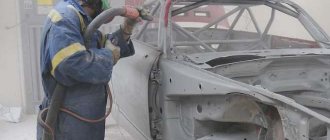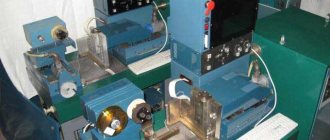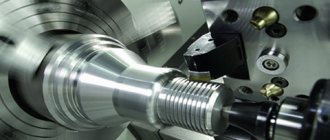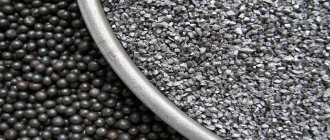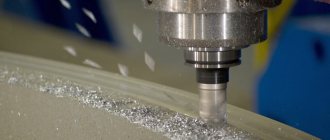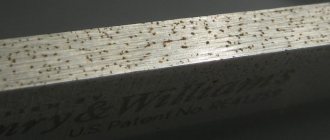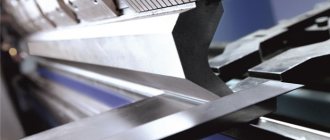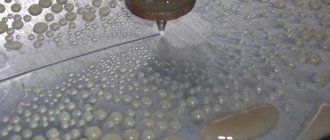Sometimes large metal structures need additional cleaning from dirt, rust and plaque. To avoid spending a lot of time cleaning with a grinder and a grinding wheel, you can use sandblasting. There is a technology that allows not only to clean the material, but also to improve its characteristics. This is shot blasting. It is important to understand how it differs from classic sandblasting and what features this technology has.
Shot blasting
Process Features
Shot blasting is a mechanical method of processing metal surfaces using metal particles. Special equipment accelerates the shot to enormous speeds (100 m/s) and delivers it to the working surface through a shot blasting nozzle. In this way, the excess layer is removed from the metal. Its depth depends on the size of the abrasive particles and the power of the equipment.
Shot blasting involves the use of an abrasive material (shot). There are several types of abrasive particles that are suitable for different types of metals and alloys:
- Glass is the most economical type of shot that does not contaminate the surface being processed.
- Electrocorundum is the most expensive and effective type of abrasive material. Used to clean serious stains.
- Ceramic is a rarely used material for making shot. Used for final cleaning of metal surfaces.
- Plastic - this abrasive is used to clean glossy parts. Does not leave marks on the material.
- Cast iron - with this shot metal surfaces are cleaned of rust, plaque, and scale. This abrasive material is made from white cast iron.
- Aluminum is a type of abrasive material for shot blasting. Used for cleaning soft alloys.
- Steel - after processing metal surfaces with this type of shot, not only the layer of dirt, plaque, and rust is removed, but also the characteristics of the material are improved.
When working with high-hardness materials, you need to choose an abrasive that is not inferior in strength to the surface being processed.
Principle of operation
The method of operation is to clean the metal coating with abrasive particles using kinetic energy. A strong jet of air directs particles onto the surface of the material with enormous speed, which can reach 730 m/s.
Due to the strong air flow with a high particle content, processing the material does not take much time, even if the product is large. For processing, special equipment is used, where particles are accelerated to high speed and then directed to the surface.
What parts can be processed?
Abrasive processing using special equipment is popular when cleaning old metal structures that have become rusty from exposure to environmental factors.
The next direction in which shot blasting is used is to remove coatings from metal surfaces. In this way, you can clean the products from layers of paint, plaque, and dirt. Using shot, a rough or matte surface is achieved, changing its structure.
What it is?
This is one of the most popular modern technologies, the essence of the process is the processing of metal using an accelerating gas flow of shot, the quality of which determines the speed and result of processing. Using this method, you can remove environmental influences, corrosion or old decorative coatings. After processing, the metal takes on a new look and becomes smoother. Unevenness and roughness are also eliminated.
Most often this technology is used to remove rust. The method is fast and reliable, which is why it is considered popular. It has been noticed that after treatment the service life is extended and the material becomes more durable.
Benefits of technology
The shot blasting procedure has a number of strengths:
- When using steel, corundum or cast iron shot, the surface is hardened.
- The high hardness of the abrasive material makes it possible to clean homogeneous materials and alloys.
- Ability to create rough and matte surfaces.
- Effective cleaning of metal from rust, scale, paint, and plaque.
- With the help of industrial equipment, labor productivity increases.
Shot blasting can quickly process large metal structures without the use of excessive effort. However, it is important to choose the right abrasive material. If its hardness is lower than that of the surface being treated, the particles will crack.
Processing of large-sized metal structures
Price of services
With a sufficient number of advantages, the question arises of the cost of these services. Basically, the price depends on the area of the metal surface being processed. On average, they can charge 350–400 rubles for one square meter. This cost is not finite and depends on a number of factors, for example, the degree of contamination or processing of the material.
Shot blasting is a complex technological process. It has a number of advantages and allows for cleaning in a short time. However, it is better to trust professionals in this matter.
Shot Blasting Equipment
You can find various shot blasting machines for metal on sale. According to the principle of operation, they are similar to sandblasting units. An apparatus for cleaning metal surfaces consists of several key elements:
- Compressor - creates a powerful air flow that throws abrasive material out of the nozzle at high speed.
- Chamber for mixing air and shot. A hose comes from the compressor through which air enters the container with abrasive. In the chamber it is mixed with abrasive and comes out through another hose.
- Nozzle. The working part through which the shot comes out and processes the working surface. It is important that this element is made of carbide materials. Otherwise, the nozzle will quickly become unusable.
There are two types of equipment
- Manual machines are low-power machines that are used for processing metal structures. Used for light work. It can be equipped with special elements that suck up used shot, clean it of debris and reuse it.
- Shot blasting chambers are automated installations that are installed in enterprises. Used for processing similar parts. They are equipped with automatic control systems, collection of waste shot with the possibility of its reuse.
For private workshops, garages, car services, manual installations are used.
Operating principle
The use of shot blasting involves the correct use of specialized equipment. For example, sandblasting works on the principle that air with abrasive comes out of the installation nozzle at high speed. The cleaning speed depends on the power of the compressor and the selected material from which the shot is made.
Shot blasting shot
Safety precautions
Shot blasting requires compliance with safety precautions:
- Work in a protective suit. Eyes, nose, ears must be closed.
- Before starting work, check the tightness of all connections and the condition of the nozzle.
- Turn off the unit if there is any extraneous noise or failure of any of the device elements.
When working with small abrasive particles, there is a risk of harm to the body due to the dust released during work.
Our equipment
Our plant operates a Gostol P-2000×500 through-type shot blasting machine with a power of 15 kW.
Shot blasting machine Gostol P-2000×500
Technical characteristics of the Gostol P-2000×500 shot blasting machine
| Maximum working width of steel sheets, mm | 2000 |
| Maximum working width of profiles, mm | 1200 |
| Maximum working height of profiles, mm | 500 |
| Minimum sheet thickness, mm | 6 |
| Maximum sheet thickness, mm | 60 |
| Passage speed, m/min | 0,5–2,5 |
| Turbine motor power, kW | 15 |
| Number of turbines | 6 |
| Turbine diameter, mm | 380 |
Features of the work
Shot blasting of metal is an industrial cleaning technology that is used when working with homogeneous metals and alloys.
Before you start cleaning, you need to select the power of the compressor, the size of the abrasive particles, and the material from which the shot is made. These indicators affect the quality of cleaning and the creation of texture. Shot blasting is a technological process for cleaning metal surfaces. With its help, you can not only remove layers of rust, dirt, and scale, but also improve the characteristics of the material.
Advantages and disadvantages
The method of shot blasting metal has the following advantages:
- removes scale efficiently;
- removes rust;
- eliminates corrosion that has formed over a certain period;
- allows you to make the surface matte;
- removes roughness and unevenness;
- extends the service life of the material;
- gives the metal strength and reliability.
As with any other method, there are several disadvantages:
- increased consumption of abrasives;
- use of a special protective suit;
- An air conditioner is required to regulate the temperature.
Equipment used for processing, metal cleaning
There are 2 options for impacting metal: through a manual mechanism and a shot blasting chamber. Each of them has its own specific functioning:
- Manual units make it possible to process parts in places with the most difficult access: in ship hulls, on bridges and on many other structures with impressive dimensions. Modern mobile models are equipped with special vacuum cleaners designed to suck in shot particles for cleaning and recycling.
- Shot blasting chambers are most often fully automated, which has a positive effect on their productivity (up to 200 m2). Such equipment is used for industrial processing of products of the same type.
Shot blasting plant (equipment),
A pass-through type shot blasting machine ensures surface cleaning of simple welded metal structures and small sheet metal products. The installation can not only clean the surfaces of products from rust, scale, welding slag and burrs, but also relieve internal stresses caused by casting and heat treatment, which helps to increase the fatigue threshold, product strength and increase the adhesion ability of the varnished surface when painting.
Purpose:
removal of strong oxide films, scale, rust from rolled metal (sheet, I-beam, channel, angle, circle, forgings, etc.) before machining, welding and for cutting in a thermal cutting installation;
processing of metal structures that have the ability to move along roller conveyors (if necessary, additional devices in the form of support strips will be used) in order to remove burrs and scale on welds;
preparing parts and metal structures for painting;
cleaning of old paint and varnish coatings;
giving the metal surface a certain degree of roughness up to Ra 2-6.3.
Shot blasting machine operating mode:
Duration of work shift: 8 hours.
Number of work shifts per day: 2.
Number of work shifts per week: 5.
Number of working days per year: 253.
Technology advantage
- After computer 3D modeling, before dynamic shot blasting, the system determines the shape and size of the shot blast chamber and places the turbines in the desired position
- The machine has automatic fault detection means, adopts Switzerland+GF+ advanced production technology, has advanced structures, design, reliable operation, high production efficiency
- The shot blast turbines used significantly increase the efficiency and high quality of cleaning
- Adopted international, the most advanced BE full curtain type sand-shot separator, greatly enhance the separation effect
- Used efficient bag dust collector with increased filtration area
- Original appearance ensures ease of operation and maintenance
Specifications
Voltage and type of current of the supply network according to EN 60204-1 standard: 3×400 -5+10% V, 50 ±1%
Hz, typ TN-CS.
Degree of protection of electrical equipment (electrical cabinets, control panels, electric motors) according to GOST 14254-2015, no less than: IP54.
Sound levels and equivalent sound levels according to GOST 12.1.003-83 (GOST ISO 9612-2016):
Power consumption: 180 kW.
Cleaning class according to GOST R ISO 8501-1-2014: Sa-2½.
Chamber type: pass-through, with simultaneous top, bottom and four-sided side processing.
Loading and unloading of processed materials: workshop lifting mechanisms.
Maximum width of the processed product: 2100 mm.
Maximum height of the processed product: 1550 mm.
Maximum load on metal structures from processed products, not less than: 800 kg/m. linear.
Thickness of processed products: from 2 to 40 mm.
To process thin rolled sheets from 2, 0.3 mm shot is used. Overall dimensions of usable space:
Corresponds to the dimensions above the floor covering: LxWxH = 24000x7000x4900 mm.
Corresponds to the dimensions under the floor covering: LxWxH=24000x5000x1500 mm Turbines:
Quantity: 12 pcs.
Direct drive from an electric motor
Design: monodisc, with straight blades and fastening without the use of springs.
Turbine impeller diameter, 380 mm.
Material: tool steel, guaranteeing wear resistance of at least 3000 hours, for impeller blades, adjusting bushings, side, top and rear guards.
The ability to turn off each turbine individually to select the optimal operating mode, with the possibility of reverse operation.
The ability to adjust each turbine individually in terms of intensity and direction of abrasive flow, depending on the type of material being processed and the quality of surface treatment.
Conveyors:
Length of mechanized feeding conveyor: 7700 mm.
Length of the mechanized receiving conveyor: 7700 mm.
Speed of movement of products on conveyor roller tables: adjustable from 0.4 to at least 4 m/min, with drive and adjustment from one drive.
Output conveyor: equipped along its entire length with a mechanized system for collecting and returning abrasive material to the shot blasting unit
Internal protection: removable panels made of manganese steel (manganese content 12...14%) with a thickness of at least 8 mm, bolted.
Entrance and exit openings: four rows of double rubber curtains. Output section:
Rotating brushes made of wear-resistant, easily replaceable segments, equipped with a system for preventing collisions with the workpiece, a soft start system and a local control unit for the height of the brush; Blowing device for removing abrasive from treated surfaces with height adjustment by control unit.
Flat surfaces of a large area (creating resonant vibrations) must be equipped with vibration-absorbing and sound-absorbing materials to meet the requirements in accordance with paragraph 7.3. technical specifications.
Maximum single maximum permissible dust concentration: no more than 0.5 mg/m³, hazard class 3.
Service life before the first major overhaul: at least 7 years.
| SPECIFICATIONS: | ||||||
| № | Name | Options | ||||
| 1 | Window dimensions for LxH processing | 2300×1800 mm | ||||
| Workpiece dimensions LxH | 2100×1550 mm | |||||
| 2 | Roller table load | ≤1t/m | ||||
| 3 | Roller conveyor speed | 0.5~4.0m/min | ||||
| 4 | Rust removal quality class | GB8923-88 AB Sa2.5, partial Sa2.0 | ||||
| 5 | Abrasive materials (cast and crushed shot) | 0.8~1.2 | ||||
| 7 | Exhaust air emissions according to GBJ4-73 standard | ≤30 mg/m³ | ||||
| 8 | Content of harmful substances according to TJ36-79 standard | |||||
| 9 | Ventilation | ≥ 20000 m³/h | ||||
| 11 Total compressed air consumption | 1.0 m³/min | |||||
12 Dimensions:
| length: | 23000 mm | |||
| width: | 4600 mm | |||
| height: | 7200 mm | |||
| pit: | 2661 mm | |||
| Detailed Specifications: | ||||
| Shot blast turbine | 12 pcs. | |||
| Shot blasting volume: | 12 x 180 kg/min | |||
| Power: | 12 × 11kW | |||
| Bucket elevator (lifting volume): | 132 t/h, 11 kW | |||
| Separator (separation volume) | 132 t/h, 7.5 kW | |||
| Longitudinal screw (feed volume) | 132 t/h, 7.5 kW | |||
| Cross auger (feed volume) | 132 t/h, 5.5 kW | |||
| Shot collection auger (feed volume) | 30 t/h, 2.2 kW | |||
| Pneumatic Shot Valve | 400 kg/min | |||
| Shot blast chamber | ||||
| In the processing area: rolled protective steel, | 16mm | |||
| Roller tables in the chamber | ø108, L800mm | |||
| Speed control method | VFD | |||
| Load: | ≤1t/m | |||
| Transport speed: | 0.5~4.0m/min | |||
| Input and output roller conveyor | ø108, L800mm | |||
| Roller conveyor width | 2300 mm | |||
| Length of inlet and outlet conveyor | 7700 mm | |||
| Roller table load | ≤1t/m | |||
| Transport speed | 0.5~4.0m/min | |||
| Drive power | 3 kW, VFD | |||
| Explosion-proof dust container | ||||
| Ventilation | 20000 m³/h, 22 kW | |||
| general power | 180 kW | |||
PLC electrical control system, automatic control - frequency or manual control, automatic detection, automatic alarm, automatic shutdown, safe system interlock.
Abrasive materials for 8000 hours of equipment operation (steel shot (ISO11124), fraction 0.8…1.2 mm)
Characteristics of shot blasting chamber:
The cleaning speed through the VFD is 0.6-1.5 m/min (in accordance with the general degree of corrosion of parts and surface requirements). The empirical value can be adjusted according to the actual situation.
Roller feed speed 0.5-4.0 m/min. To achieve frequency regulation, customization is possible according to actual conditions.
A settling tank between the shot blasting chamber and the dust collector facilitates the recovery of shot. Annual shot savings of 5-6 tons.
Shot consumption is about 80-120 g/m².
Actual hardware configuration
Subject to abrasive loads, blaster parts are made of high chromium material, blade service life
The protective screen in the processing area is made of high-strength rolled steel. The one-piece skid plate is welded from the outside, without bolts.
Dust collector: bag dust collector, fan power 22 kW, dust removal efficiency up to 99.5%.
The PLC control device with touch screen, fully automatically measures and controls the operating time of the turbine and automatically reminds you to replace wear parts.
Solutions
Equipment safety is ensured by the use of protective screens on drives, warning signs of hazardous areas, and the use of bright colors.
Emergency stop panels are located in all hazardous areas and the electronic control panel.
Closed-loop safety system for shot feeding on a shot blast turbine
Main materials used
The armor of the shot blast chamber is hot-rolled steel 10-12 mm.
High quality shot blast turbine, made of high chromium steel,
Secondary separation device, drum screens from shot and dust to ensure efficiency and surface cleanliness.
Power elements
Compositions and features of shot blaster
The plant is composed of roller conveyor, front and rear sealing chamber, shot blast chamber, shot blast turbine assembly, dust collection system, and electric control system and shot circulation cleaning system, etc.
Transport Roller Conveyor
The transport system includes an input and output roller conveyor and a roller conveyor in the shot blast chamber. The total length of the conveyor system is 23 meters. The production line strictly synchronizes the roller system. All rollers have a VFD motor drive that supports a speed of 0.5 ~ 15 m/min. System capacity up to 1 t/m.
The input, intermediate and output roller shafts are made of high quality carbon steel seamless tubes with coated shaft journals.
Using computer dynamic modeling, the rollers in the shot blasting chamber completely eliminate the direct impact of shot and its rebound. In addition to the fact that all rollers are equipped with easily replaceable high-chromium high-resistant casings, both ends of the shaft axis use labyrinth sealing made of manganese steel high-resistant material, which completely eliminates abrasive wear of the bearings at both ends.
Next to each roller group there is a control panel that allows you to manually adjust the speed. With automatic control, the entire roller line is meshed with stepless speed adjustment; With manual control, each roller segment can be adjusted individually, which helps to adapt to the working rhythm, adjustment and maintenance of each roller segment.
Shot blasting chamber
The shot blasting chamber consists of a front sealed chamber, a shot blast chamber, a rear sealed chamber, a shot circulation system, and a dust collector system.
Front and rear sealed chambers
Multi-layer ring chain hermetic curtains and high-resistant rubber curtains are hung at the entrance and exit of the products. The suspended structure is easy to change and maintain. This device is hermetically sealed. The dust removal fan creates a certain vacuum in the vacuum chamber and eliminates the emission of dust.
The front and rear sealed cameras are protected by a screen.
Shot blast chamber
The shot blasting chamber is made of high-quality profiles and steel sheets, and has sufficient strength and rigidity. The chamber shape, size and installation position of the shot blast turbine are optimized using CAD and designed in dynamic simulation mode. This in turn provides a better shooting angle and distance, so that the products receive the best cleaning effect and the installation exhibits maximum efficiency.
The shot blast chamber body is completely protected from the inside by special wear-resistant plates (armor) made of manganese steel.
The one-piece skid plate is welded from the outside, without bolts. The lower auger is protected by a screen and has a long service life.
Shot blast turbine
This shot blasting machine has 12 turbines located at an angle, providing an optimal flow of shot onto the surfaces to be cleaned.
The shot blast turbine has high efficiency and is easy to install and repair. During rotation, the blades are pressed under the influence of centrifugal force. To remove the blades, just lightly hit the outside and it can be easily removed. It will take 10-20 minutes to remove all eight blades. At the same time, the wear condition of the guide cage and impeller can be checked.
Each shot blast turbine has 8 blades. The difference in weight of each blade is less than 3 grams.
The blade is made of high-chromium wear-resistant material and after processing the hardness is achieved on the order of HRC60-65. Which ensures a long service life.
The blades installed in the groove can be removed without tools, making the installation easier to maintain.
The control holder and distributor are made of high-chromium wear-resistant material, surface hardness HRC60-65.
Internal protective plates made of chromium alloys.
Impeller made of chromium structural alloy steel.
This shot blast turbine features high efficiency, low noise and low energy consumption.
Fraction circulation system
The shot circulation system consists of a spiral conveyor, a bucket elevator, a shot-sand separator, a shot feed controller and a shot pipe.
Spiral conveyor
The conveyor includes a gearbox, a spiral shaft, and a housing. This is a standard horizontal abrasive conveyor. It has high versatility, interchangeability, stable and reliable properties. The entire spiral conveyor is machined after welding to ensure concentricity. The internal and external surfaces are also processed using a special technology, which increases the service life and reduces noise.
Bucket elevator
The bucket elevator is composed of cycloidal gearbox, upper and lower drums, conveyor belt, hoppers, closed barrel, anti-reverse device and tension device, etc.
The bucket elevator is connected to a spiral conveyor (shot input) and a separator (shot output). The lift body is made of welded steel sheet. The inspection hatch is located in the housing for maintenance and changing buckets. For comfort, a door is located in the lower part of the body for repairs and to prevent clogging with shot.
To avoid slipping of the conveyor belt, the drum consists of original perforation. This design not only improves the friction force by avoiding slipping, but also reduces tension when lifting the belt, and also extends its service life.
A pulse sensor is installed on the lower shaft of the elevator, taking readings and ensuring the working condition of the elevator. When the lower shaft drive stops, the PLC immediately outputs a fault signal and generates information, giving an alarm to ensure the safety of the equipment.
Shot-sand separator
The separator is one of the key components of the equipment, the size of the separation zone directly affects the separation effect significantly. This BE separator is a full curtain type, manufactured using the latest technology. It includes screening areas, a shot hopper, a controlled shot valve, etc.
With a high separation effect, providing an increased service life of the gun nozzle and reducing maintenance costs.
Principle of operation:
When the separator is operating, a spiral conveyor transports the shot and sand mixture that comes from the bucket elevator to a reserve port at the end of the separator. The stream of fractions begins to overwhelm.
Under sealing condition, under the influence of gravity, the dust suction fan effectively separates shot, metal oxide debris, broken shot and dust. The sieve blocks large waste, small shot and dust that enter the waste outlet, the selected shot is again sent to the shot hopper for further use. The separation efficiency of the separator is at least 99.5%.
Dust collection system
The dust collection system consists of a baghouse dust collector, an exhaust fan and connecting piping between the dust collector and the fan. The installation implements a three-stage dust removal mode. The first-stage dust collector is the settling chamber. The settling chamber is based on the aerodynamic principle. This allows for efficient separation of shot without loss of pressure. The purpose of this unit is to solve the problem of accumulative sand in the pipeline.
The second stage of the dust collector is based on inertial dust removal. Its purpose is to separate large particles, increasing the service life of the filter material.
The third stage of the dust collector is a highly efficient bag filter. It uses pulse backflow system technology, with low filtration speed, high precision and backflow. Which gives a good dust cleaning effect.
Dust removal efficiency is above 99.9%. Dust emissions in the exhaust gas are no more than 30 mg/m³, in accordance. Exhaust gas generated during operation may be discharged into the atmosphere after processing the dust collector. This filter uses a 22 kW fan, total ventilation 20,000 m³.
The service life of the filter element is at least 3 years.
Safety precautions
The use of a shot blasting device is an effective way to process metal surfaces. However, such a procedure can have a negative impact on human health: the fine abrasive released along with dust contributes to the occurrence of respiratory diseases. It is possible to prevent such consequences only by strictly observing safety requirements.
Workplace for manual equipment
During the operation of a mobile shot blasting machine, under no circumstances should a compressor or receiver be placed near it; they must be separated from the working area. The processing procedure itself requires high-pressure air flow.
Important!
The presence of strangers without personal protective equipment on the site while shot blasting equipment is operating is prohibited.
Working with a stationary device
To avoid problems with the operation of camera equipment, it should be installed only on the territory belonging to the production enterprise. It should also be separated from the rest of the work area to prevent air pollution.
In the area with the shot blasting chamber, it is necessary to install a high-power ventilation system. It is not recommended to install the hood directly above the unit, as it will quickly fail.
Worker's suit
The operator of shot blasting equipment must be at the workplace only with personal protective equipment. The kit includes the following items:
- special mittens;
- air filter;
- helmet-mask equipped with an air duct;
- protective suit.
Due to a number of advantages, shot blasting equipment is very popular. This processing method allows you to remove dirt, carbon deposits and rust from metal surfaces. To ensure that handling shot blasting is not accompanied by negative consequences, it is necessary to carefully consider the location of its installation and familiarize workers with safety precautions.
Rights
A 4th category shot blaster has the right to:
3.1. Get acquainted with the draft decisions of the enterprise management concerning its activities.
3.2. Submit proposals for improvement of work related to the responsibilities provided for by this job description for management's consideration.
3.3. Inform your immediate supervisor about all shortcomings in the production activities of the enterprise (its structural divisions) identified during the performance of your official duties and make proposals for their elimination.
3.4. Request personally or on behalf of the immediate supervisor from heads of departments of the enterprise and specialists information and documents necessary to perform their job duties.
3.5. Involve specialists from all (individual) structural divisions of the Company in solving the tasks assigned to him (if this is provided for by the regulations on structural divisions, if not, with the permission of the head of the Company).
3.6. Require the management of the enterprise to provide assistance in the performance of their official duties and rights.
Responsibility and performance evaluation
4.1. A 4th category shot blaster bears administrative, disciplinary and material (and in some cases provided for by the legislation of the Russian Federation, criminal) responsibility for:
4.1.1. Failure to carry out or improperly carry out official instructions from the immediate supervisor.
4.1.2. Failure to perform or improper performance of one's job functions and assigned tasks.
4.1.3. Illegal use of granted official powers, as well as their use for personal purposes.
4.1.4. Inaccurate information about the status of the work assigned to him.
4.1.5. Failure to take measures to suppress identified violations of safety regulations, fire safety and other rules that pose a threat to the activities of the enterprise and its employees.
4.1.6. Failure to ensure compliance with labor discipline.
4.2. The assessment of the work of a 4th category shot blaster is carried out:
4.2.1. By the immediate supervisor - regularly, in the course of the employee’s daily performance of his labor functions.
4.2.2. The certification commission of the enterprise - periodically, but at least once every two years, based on documented results of work for the evaluation period.
4.3. The main criterion for assessing the work of a 4th category shot blaster is the quality, completeness and timeliness of his performance of the tasks provided for in these instructions.
